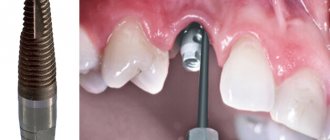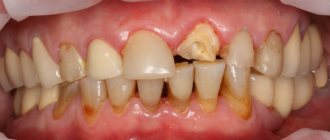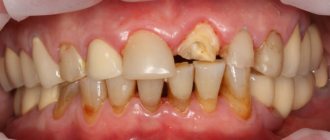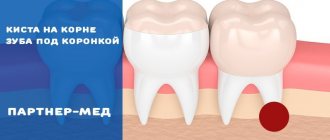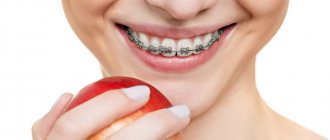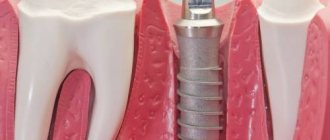13.01.2020
Almost everyone has experienced toothache at least once in their life. When it comes to ordinary caries, one visit to the dentist is often enough and the problem will be solved. But there may be a more serious pathology that requires immediate intervention, and sometimes a careful choice of treatment method. For example, a dental cyst, this also happens. Then the question arises: is it possible to remove a cyst without removing a tooth? We will try to answer this in as much detail as possible.
What is a cyst?
This is a benign tumor that appears as a response of the immune system to the penetration of pathogenic bacteria. Its formation can also be caused by tooth trauma or improper treatment of oral diseases.
Most often, a cyst forms in the upper part of the tooth. Unfortunately, it is almost impossible to determine the presence of such a formation in the first stages of development of the pathological process, even during an examination by a dentist. The disease can proceed for many years without showing any signs, and then the question suddenly arises: is it possible to cure a dental cyst without removal?
All doctors will unanimously tell you that such a pathology definitely requires therapy, otherwise serious consequences are possible in the form of fistulas, and it’s not far from blood poisoning, not to mention the loss of a tooth, or even more than one.
More recently, due to the lack of modern dental equipment, this problem could only be dealt with by a radical method - removing the cyst along with the tooth. But now it is possible to treat a dental cyst without removal. Kazan, for example, happily opened the doors of a clinic for its residents, where experienced professionals will relieve you of this problem and preserve bone tissue as much as possible. The clinic is located at the address: Chistopolskaya street, 77/2. You can call in advance and make an appointment.
Accelerated rehabilitation after surgery
For patients who want to go through the recovery process without such consequences, our Center provides a complex of accelerated rehabilitation on the day of surgery :
Therapy without removal
If this formation was detected in the early stages of development, the dentist may suggest drug therapy. This is possible if a new formation of connective tissue has appeared on the root of the tooth, but has not yet filled with fluid. It's called a granuloma. You can try to get rid of it without surgery. This is what it looks like:
- During a visit to the dentist, a canal is opened to get to the growth on the root of the tooth.
- All channels and cavities are well cleaned.
- The doctor will definitely add medicine to prevent further growth of bacteria.
- A temporary filling is placed on top to prevent the medication from falling out and to prevent food particles and liquids from getting inside.
Therapy does not end with this visit. The doctor will most often prescribe a course of antibacterial drugs to relieve the inflammatory process. You will need to visit your doctor periodically to monitor the progress of the treatment process.
If the dentist sees that the cyst is gradually resolving and decreasing in size, then the therapy is successful. Otherwise, the question will arise: is it possible to cure a dental cyst without removal?
Indications for cyst removal
When a cyst is at the initial stage of development, it is quite problematic to detect it, this is its whole danger. It can develop completely asymptomatically for a long time, the patient will be completely confident that everything is in order with his teeth, until one fine moment he feels a piercing, sharp pain. The following symptoms may also be observed:
- Increased body temperature.
- The gums and cheek swell.
- General health worsens.
- A headache appears due to the formation of a cyst.
- Lymph nodes increase in size.
Removing a cyst without removing a tooth or together with it is simply necessary, since it injures not only the tooth on the root of which it formed, but also the neighboring ones. As it grows, it displaces them and injures the roots. The human immune system suffers, as well as almost all important organs.
Drug therapy in such cases will no longer give effective results, so you will have to resort to surgical intervention. But there is no need to worry about this: now dentists know how to cure a tooth cyst without removal. If the tooth itself is not destroyed, then the doctor will under no circumstances remove it.
Types of dental cysts
A molar cyst is distinguished by several characteristics:
- depending on the reasons for the appearance;
- according to location.
Distributing according to the reasons that provoke the appearance of a dental cyst, the following varieties are distinguished:
- A keratocyst appears on the lower jaw. Older people are susceptible to the disease. It can turn into a malignant form - it grows deeply into the body and destroys the bone.
- Odontogenic or radicular dental cyst is the most common type. After periapical inflammation and necrosis of the pulp, a granuloma of the dental root is formed in the upper part. The size of the purulent focus ranges from 3 mm to 3 cm. The process does not affect bone tissue and does not provoke tooth displacement.
- A cyst that forms at the site of teething is a retention cyst. It appears during the period of replacement of milk teeth with molars. A purulent fistula with bloody contents looks like a dark blue abscess. Education is formed if the process of eruption is slow. The purulent contents of the abscess should be opened and cleaned out.
- A calcifying odontogenic tumor occurs in the area of the support of the lower jaw. Experts do not have a consensus on the reasons for its formation - they have not yet been fully studied.
- A residual formation with pus occurs after tooth extraction as a result of careless work by the doctor. If a piece of root or a fragment of a tooth remains in the wound, a granuloma forms.
- A follicular cyst forms in place of soft tissues that resist the eruption of a new tooth. A cyst grows around a tooth hidden by the gum, enlarges and can spread to other teeth. The result of the development of a cyst can be tilting, tooth displacement or root resorption.
- A lateral periodontal cyst looks like a small formation, most often found on the lateral part of the root.
Depending on the location of the purulent tumor, there are:
- A cyst is formed on a tooth root. Three location options: basal, inter-root or peri-root zones. When a purulent capsule forms, the disease manifests itself well.
- The purulent focus is located in the maxillary sinus. Making a diagnosis is extremely complicated - you cannot do without an image of a certain area. In the advanced phase, the cyst provokes the appearance of sinusitis.
- At the initial stage, a cyst on the gum is asymptomatic. At the moment of filling with purulent contents, the bubble begins to grow rapidly. In treatment, medications are used, and they are also fought by puncturing the capsule, treating with saline solution and cleaning until complete healing.
- The formation of a cyst under the tooth crown occurs after unsuccessful disinfection during its installation after treatment. As a result of a loose fit, food debris gets under the crown, rots and creates a favorable environment for cyst growth. To treat it, you need to remove the crown.
- A cyst on the front teeth has practically no room for development and localization. It comes out at the initial stage of development.
- A wisdom tooth cyst forms at the site of a long-erupting “figure eight.” As a treatment for this category of teeth, a proven effective method is recommended - removal of the cyst and wisdom tooth together.
How to cure a tooth cyst without removal?
Modern medicine is moving further and further every year in mastering the latest methods of treatment and dental prosthetics. Nowadays, for any pathology, tooth extraction is carried out only if its crown cannot be restored.
For modern dentists, a cyst is also not a big problem; most often, one visit to the doctor is enough to cope with this pathology. Removing a cyst without removing a tooth is much easier to do than identifying this disease. The thing is that a cyst can only be recognized on an x-ray, and such a referral is given only in emergency cases.
Methods for treating cysts without tooth extraction
When a patient comes to see a dentist with complaints about the above symptoms, during the examination the doctor determines the degree of damage to the soft tissues and the location of the tumor. After this, he decides whether it is possible to treat the dental cyst without removal. Dentists have several methods of such therapy in their arsenal:
- Therapeutic treatment.
- Surgical.
- Laser.
Each has its own advantages and disadvantages, but the choice will depend on the severity of the pathology.
Let us analyze in detail each method of treating cysts.
Cystotomy
Surgical treatment of a cyst with this method means removing its shell, but not all of it, but only covering the outer surface. Excision of the cystic membrane creates access to the internal cavity for treatment with bactericidal compounds.
At the end of the sanitation, the detached flap of soft tissue is placed in the vacant space where the cyst used to be.
Cystotomy is indicated if the cyst:
- has reached significant proportions;
- covers 3 or more healthy teeth;
- leads to destruction of jawbone tissue.
Cystotomy surgery is less traumatic than cystectomy, and the early rehabilitation period is more comfortable for the patient. But tissue healing takes longer.
Therapeutic treatment
This type of therapy is performed through a root canal. The tooth does not suffer at all after this treatment. It is believed that this method of dealing with cysts is the safest. Here are the stages to go through:
- The doctor cleans the tooth canal and removes the pulp.
- The top of the formation is cut off, and all the purulent contents are pumped out of it.
- The entire cavity is treated with an antiseptic drug.
- The doctor places a healing paste inside, which helps accelerate cell regeneration.
- Placing a temporary filling to prevent food from getting inside.
Removal of a cyst without tooth extraction can be carried out in another therapeutic way:
- The dental canal is opened and completely cleared of pus.
- Copper-calcium oxide is poured into the cavity and a weak electrical effect is exerted on it.
As a result of this procedure, the substance in the cavity moves and is distributed over the entire surface, removing most of the bacterial cells. It is not possible to completely cope with the pathology in one such procedure; you will have to do it several times.
After some time, the patient comes for a second appointment, and the doctor, removing the temporary filling, assesses the degree of healing. If the process goes as planned, then after some time it will be possible to install a permanent filling and forget about the problem.
At this point, we can assume that the treatment of the dental cyst without removal was successful and completed.
Complications without treatment
Sometimes cysts grow to enormous sizes, causing destruction of the jawbone. Their growth occurs especially quickly in the upper jaw due to the characteristics of the bone tissue - it is more porous than in the lower jaw. The formation on the upper jaw can go into the maxillary sinus and provoke ENT diseases. Complications from an untreated cyst can be very serious:
- root destruction, loosening and tooth loss;
- osteomyelitis – destruction of the bone tissue of the jaw;
- sinusitis;
- inflammation of the lymph nodes;
- phlegmon - purulent inflammation in the oral cavity;
- inflammation of the periosteum (periostitis);
- spread of infection throughout the body, which can lead to sepsis and other serious consequences.
Surgical removal of the cyst
We have already noted that the cyst is an insidious neoplasm, because in the first stages of its development it does not show any signs at all and does not bother the patient. Diagnosing a tumor in the late stages forces dentists to resort to surgery to help the patient. Treatment of a dental cyst without removal in Vitebsk, for example, can be carried out efficiently in a dental clinic. Experienced specialists, using modern equipment and the latest technologies, relieve their patients of suffering and remove the cyst quickly and painlessly.
To remove a tumor, dentists use several techniques:
- Cystotomy. During this procedure, the doctor partially removes the membrane of the tumor so that the purulent contents can be removed. As a rule, this method is used when the cyst is quite large, or there is a risk of damage to neighboring tissues. All manipulations are performed under local anesthesia, so the patient will not experience any discomfort.
- A cystectomy is the complete removal of a cyst. Patients can rest assured: the procedure, unlike other methods, is painless, and the tooth will remain intact and intact.
- Resection. When using this technique, the doctor removes the cyst and part of the apex of the tooth root on which it was located. The work can only be done by a true master of his craft. If treatment of a dental cyst without removal is required, Ryazan can boast of such specialists, for example, at the Lyudmila clinic.
- If upon examination it is discovered that the root of the tooth is severely damaged, then it is better to perform a hemisection, when the cyst is removed along with the tooth. This is more reasonable, since the infection, remaining in the tissues, will lead to an inflammatory process. After removal of the dental cyst, it is possible to carry out a complete restoration, so the patient’s smile will not be affected.
Hemisection
Hemisection is the amputation of part of a tooth, which can be performed in two ways. The first - patchwork - involves excision of only the root if the crown of the tooth is completely healthy.
Surgical treatment of the cyst using the flap method allows you to save the crown, since access to the cyst is created through detachment of the gum. After excision of the root, the gingival flap is returned to its original place and sutured.
Dentists call the second method “removal from above”: it involves transverse dissection of the tooth and extraction of the affected fragment.
Hemisection is carried out only if one of the roots is affected, when the infection has not spread to the rest. The disadvantage of such an intervention is a significant decrease in the resistance of the “truncated” dental unit to loads.
There is a risk that the tooth will not withstand the pressure and will have to be removed later. However, you should not refuse the procedure, since a tooth treated with hemisection can be a support for removable dentures.
Hemisection surgery is the only solution in the presence of tortuous and difficult-to-pass root canals that cannot be properly cleaned and sealed.
Hemisection is often prescribed for children and adolescents. After this is completed, a crown is placed on the remaining part of the tooth. For young patients under 20-25 years of age, the opportunity to save a tooth is especially important, since it is too early to place implants due to incomplete skeletal growth.
Full recovery after surgery is completed in a week and a half.
Cyst removal procedure
The operation to remove a cyst requires some preparation, so if there is no particular urgency, the doctor and the patient discuss the time of removal of the tumor. Although the procedure will be performed under anesthesia, it is still an operation that involves cutting the gum and removing the nerve, so bleeding is possible. To reduce the risk of unwanted effects, the patient is recommended to:
- The day before surgery, do not drink alcoholic beverages.
- Reduce the number of cigarettes you smoke.
- Avoid caffeinated drinks.
You shouldn’t refuse food; on the contrary, you need to eat before going to the hospital, since then you won’t be able to do it for some time.
The work of a dentist will consist of the following stages:
- X-rays are used to determine the exact location of the cyst. This can be done using computed tomography.
- Anesthesia is administered.
- After the anesthesia has taken effect, the doctor will drill a hole in the tooth and remove the nerve.
- The next stage involves thorough cleaning of the canals and treatment with antiseptic agents.
- A seal is installed.
- Next, the doctor makes an incision in the gum and removes the cyst along with the root or only part of it.
- The resulting cavity is filled with plasma from the patient’s blood or a special biological substance.
- The wound is sutured.
What is the difference between a cyst and a granuloma?
There are other diseases in the oral cavity that are symptomatically similar to a cyst. Specifically, a granuloma is an outwardly swollen round projection in the root zone of a tooth. The doctor must correctly diagnose the disease, since the sequence of exposure, removal techniques, and pharmacology have significant differences. Granuloma is eliminated with the help of medications, as well as accompanying mouth rinsing with phytocomponents. The cyst has deeper roots and does not go away without surgery.
Carrying out a cystectomy
Removing a dental cyst without surgery is not always possible, so cystectomy is performed quite often if it is necessary to get rid of such a tumor. To carry out the procedure, the doctor will need ultra-thin instruments, dental optics and a laser, which is used to sterilize the cavity. Ultrasound can be used for these purposes.
The whole operation boils down to the following:
- Local anesthesia is administered.
- The dentist drills a hole in the tooth to clean out the dental canals.
- A microcamera is inserted into the prepared cavity, and the exact location of the cyst can be seen on the monitor.
- Using special devices, the doctor cleans the dental canals and makes them wider.
- Next, the cyst is opened and its contents are removed.
- All surfaces are laser treated to kill bacteria.
- An antiseptic is injected into the cyst.
- After all this, you can fill the canals and start restoring the tooth.
All manipulations take the doctor about an hour. After the operation, the patient remains in the chair for some time so that his condition can be monitored, and then he goes home. As a rule, a repeat visit to the dentist is not necessary, since the cyst will completely resolve under the influence of the administered medication. If you live in Moscow and you need treatment for a dental cyst without removal, the Eastern Administrative District (Eastern Administrative District) opens the doors of a medical center for its residents at Sirenevy Boulevard, 32. Experienced specialists will do everything quickly and efficiently.
Using a laser to remove a cyst
Modern dental clinics can offer their patients an alternative method - laser removal of dental cysts. This procedure is performed using laser therapy. The method is completely painless, and the tumor can be dealt with quickly and effectively.
The procedure is carried out as follows:
- The dental canal is freed.
- A laser is introduced into it, which destroys the membrane of the tumor and burns the wall, disinfecting it.
Treatment of dental cysts without laser removal has its advantages:
- No preparation is required to remove the tumor.
- Relapses are virtually eliminated.
- After such removal, the patient recovers very quickly.
Of course, there are also disadvantages: firstly, the high cost of the procedure, so not all patients can afford it, and secondly, the possibility of using this method only in the presence of a small tumor.
Traditional medicine against cysts
You can try to treat a dental cyst without removal, using folk remedies. They will help relieve swelling and resolve the tumor. As such, we can offer the following recipes:
- Using salt water. To do this, you need to take 250 ml of boiled water and add 1 tsp. salt or soda. Rinse several times a day. This will help relieve pain.
- Prepare an infusion by taking 1 tablespoon each of horsetail, sage, eucalyptus, thyme, chamomile and calendula. Pour boiling water over and leave for about 4 hours. Use for rinsing 2 times a day.
- You can use alcohol infusions for disinfection, but they can increase pain. It is also necessary to remember that such infusions are only allowed for use by adults.
- The antiseptic properties of hydrogen peroxide are known, so it can be used for rinsing, but first diluted with water in a 1:1 ratio.
- Lemon juice, if diluted with water in a 1:1 ratio, can also be used to rinse after each meal. It will relieve swelling and remove redness. Those who are allergic to citrus fruits should be careful with this product.
- Garlic is very popular in the fight against cysts. It is used as a rub into the gums. In the first moments there will be severe pain, but then it will be felt less and less. The disinfecting properties of garlic are known, so using it will not harm.
- You can use essential oil as a remedy; it is best to choose almond or mint. They cope well with infection and relieve pain. You can buy it at any pharmacy and use it for rinsing several times a day.
When starting to treat a cyst using folk remedies, it is important to be aware that such therapy cannot always help. The apparent relief may hide further development of the tumor. At the first signs of pathology, it is better to visit a competent specialist who will recognize the problem and suggest the most effective way to get rid of it. A cyst is an insidious formation, and if you do not pay attention to it and relieve the pain with painkillers and rinses, after a while it can spread from one tooth to the neighboring one. So is it worth exposing yourself to the risk of losing several teeth at once, if you can immediately consult a doctor for medical help?
Category Miscellaneous Published by Mister dentist


